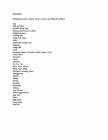31
P2011.40.1: Hugh Stroud delivering milk on a dog sled, circa 1929circa 1929
McMurray, Alberta, Canada
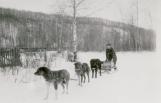 Credits:
Credits:Hugh Stroud
Fort McMurray Historical Society
32
P2011.40.9: Hugh Stroud & Eymundson children on Sled Island with fox and lynx pelts, 19241924
McMurray, Alberta, Canada
 Credits:
Credits:Hugh Stroud
Fort McMurray Historical Society
33
P2011.40.47: Hugh Stroud, his mother, Romeo & Iona Eymundson with their furs on Sled Island, 19241924
McMurray, Alberta, Canada
 Credits:
Credits:Hugh Stroud
Fort McMurray Historical Society
34
Playground Activities:A toboggan run had been constructed for the students in the 1920s, along with a merry-go-round in the schoolyard.
Some games that the children played included: Pom Pom Pudaway, Prisoner's Base, Silver Apples - Golden Oranges, Tug-of-War, Anti-Over, and various sports.
Baseball was a popular activity in the spring and fall, while hockey was often the chosen activity for the cold, winter months. By 1935, several McMurray students had organized a minor team that they named the Cubs baseball and hockey teams. Games were held against Waterways and other students and teams in the area.
35
P2010.9.12: Cassia McTavish with students outside first schoolhouse in winter with toboggan, c. 1914circa 1914
McMurray, Alberta, Canada
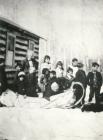 Credits:
Credits:Bob Duncan
Fort McMurray Historical Society
36
P2008.123.2: Children tobogganing down a six-person slide at St. John's School, circa 1950circa 1950
McMurray, Alberta, Canada
 Credits:
Credits:Fort McMurray Historical Society
38
P2008.207.9: Grade 8 students playing baseball, circa 1930circa 1930
McMurray, Alberta, Canada
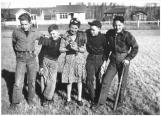 Credits:
Credits:Fort McMurray Historical Society
39
P2008.399.1: McMurray Cubs Hockey Team, circa 1935circa 1935
McMurray, Alberta, Canada
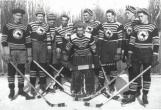 Credits:
Credits:Fort McMurray Historical Society
40
P2008.399.2: McMurray Cubs Baseball Team, circa 1935circa 1935
McMurray, Alberta, Canada
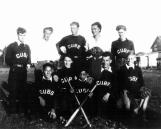 Credits:
Credits:Roy Hawkins
Fort McMurray Historical Society
41
George Clausen doing high jump at track meet, circa 1945circa 1945
McMurray, Alberta, Canada
 Credits:
Credits:Clausen Family Private Collection
Fort McMurray Historical Society
42
Discipline in the School:While the strap was rarely used, it was always kept in the teacher's desk as an ominous reminder to not misbehave.
Younger students who misbehaved stood in the corner, facing the wall, while older students were asked to stay after class to write lines on the blackboard. Sometimes students had to stand in the corner of the room, far away from the stove in the winter and think about what they had done.
When Mr. McTavish taught classes in order to assist his wife, he was remembered as being fairly strict with the students. He walked around the classroom with a yardstick and tapped students on the head with it if they were acting inappropriately or speaking in class.
In her book, Memories of a Metis Woman, Alvena Strasbourg shares an anecdote of punishment she witnessed at the McMurray School when she was a young girl,
"In the spring, a sea of mud surrounded the school. With all our jumping and running, no grass grew in the yard. When the boys got a new football, the mud spread a little further - usually onto them. One day, when the teachers went home for their lunch, the boys brought the ball into the school. After tossing it around, they decided to bounce it off the walls. White walls! When the principal returned, he took one look at the walls and roared. He lined all the boys up against the wall, oldest to youngest, and took out the strap. By the time he was halfway through strapping the older boys, the younger ones were howling in terror. Rather than strap them, he just let them stand and bawl. The bigger boys had to scrub the walls white again before they went home that night. Nobody tried that again!"
43
School Artifacts: The Strapcirca 1915
Heritage Park, Fort McMurray, Alberta, Canada
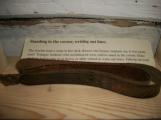 Credits:
Credits:Photographer - Sarah Robertson
Fort McMurray Historical Society - Interpretive Items
44
Teachers' Wages:Cassia McTavish worked without compensation for her first five years because there was no money to pay her. The school board was close to bankruptcy until it was saved by extra tax dollars in 1919.
Over the years, It was difficult to hire male teachers because the community was isolated and male teachers had an obligation to provide for their families. As a result, young, single female teachers often held these positions. They were usually provided with the teacherage or some other form of accommodations - sometimes a room in a student's family's house. The wages were minor, but the ladies were able to get by on those means at the time. The Grey Nuns volunteered to staff the Catholic schools. The women worked hard, but were paid little. The nuns, including principals, earned $100 a month, which they dutifully returned to the St. John's Separate School District.
By 1954, the salary was up to $2300, with an extra $800 if the teacher held a university degree, a further $100 for a second degree, and a small bonus for any additional courses, as well as a housing allowance of $150... per annum!
